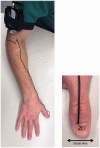Quantifying performance metrics of cervical spine mobilization for improved education and clinical outcomes: Early experience with a novel wearable device
- PMID: 31191931
- PMCID: PMC6453047
- DOI: 10.1177/2055668318765396
Quantifying performance metrics of cervical spine mobilization for improved education and clinical outcomes: Early experience with a novel wearable device
Abstract
Introduction: Evaluation of manual skills training for spinal rehabilitation has been stagnant for 40 years. Observation and mimicry are coupled with feedback from "expert" observers to train and evaluate learners, relying on rater experience to discern speed and force. Spinal manipulation is a controlled act under the Regulated Health Professions Act (1991) as it is not without risk. The discordance between current methods for evaluating proficiency and the potential risks of inadequate application is a critical gap.
Methods: This work reports a novel wearable device that measures finger forces via microstrain bending of the physiotherapist's nail. The device leaves the tactile finger pad unobstructed and does not interfere with treatment application. Five expert-level physiotherapists performed a standard postero-anteriorly directed spinal segmental mobilization treatment for 1 min at 1-1.5 Hz rhythm.
Results: The device successfully measured all treatment forces (0.2-27.3 N). Physiotherapists applied a maximum force rate of 0.03 ± 0.01 N/s with a rhythm of 1.76 ± 0.38 Hz. In 15 trials, there were no device failures. The device was easily applied and removed, and physiotherapists were able to walk about and interact normally with patients.
Conclusions: These results indicate that this technology can be integrated into a skills training program to provide quantitative feedback for objective assessments.
Keywords: Manual skills training; rehabilitation; sensors/sensor applications; spinal rehabilitation; tactile sensors.
Conflict of interest statement
The author(s) declared no potential conflicts of interest with respect to the research, authorship, and/or publication of this article.
Figures



Similar articles
-
A comparison of cervical spine mobilization forces applied by experienced and novice physiotherapists.J Orthop Sports Phys Ther. 2010 Jul;40(7):392-401. doi: 10.2519/jospt.2010.3274. J Orthop Sports Phys Ther. 2010. PMID: 20592483
-
Wearable strain gauge-based technology measures manual tactile forces during the activities of daily living.J Rehabil Assist Technol Eng. 2018 Nov 18;5:2055668318793587. doi: 10.1177/2055668318793587. eCollection 2018 Jan-Dec. J Rehabil Assist Technol Eng. 2018. PMID: 31191951 Free PMC article.
-
Forces applied to the cervical spine during posteroanterior mobilization.J Manipulative Physiol Ther. 2009 Jan;32(1):72-83. doi: 10.1016/j.jmpt.2008.09.012. J Manipulative Physiol Ther. 2009. PMID: 19121465
-
Manual forces applied during posterior-to-anterior spinal mobilization: a review of the evidence.J Manipulative Physiol Ther. 2006 May;29(4):316-29. doi: 10.1016/j.jmpt.2006.03.006. J Manipulative Physiol Ther. 2006. PMID: 16690387 Review.
-
Transoral Robotic Surgical Proficiency Via Real-Time Tactile Collision Awareness System.Laryngoscope. 2020 Dec;130 Suppl 6:S1-S17. doi: 10.1002/lary.29034. Epub 2020 Aug 31. Laryngoscope. 2020. PMID: 32865822
Cited by
-
Devices Used to Measure Force-Time Characteristics of Spinal Manipulations and Mobilizations: A Mixed-Methods Scoping Review on Metrologic Properties and Factors Influencing Use.Front Pain Res (Lausanne). 2021 Oct 29;2:755877. doi: 10.3389/fpain.2021.755877. eCollection 2021. Front Pain Res (Lausanne). 2021. PMID: 35295511 Free PMC article.
-
The effect of real-time feedback on learning lumbar spine joint mobilization by entry-level doctor of physical therapy students: a randomized, controlled, crossover trial.J Man Manip Ther. 2020 Sep;28(4):201-211. doi: 10.1080/10669817.2019.1673953. Epub 2019 Oct 8. J Man Manip Ther. 2020. PMID: 31593528 Free PMC article. Clinical Trial.
References
-
- Ernst E. Deaths after chiropractic: a review of published cases. Int J Clin Pract 2010; 64: 1162–1165. - PubMed
-
- Senelick RC. Chiropractic manipulation can cause a stroke. Huffington Post 2012.
-
- Press WF. Group wants provincial ban on some neck manipulation by chiropractors, Winnipeg Free Press, Winnipeg Canada, 2012.
-
- Carlesso LC, Gross AR, Santaguida PL, et al. Adverse events associated with the use of cervical manipulation and mobilization for the treatment of neck pain in adults: a systematic review. Man Ther 2010; 15: 434–444. - PubMed
LinkOut - more resources
Full Text Sources
Miscellaneous

